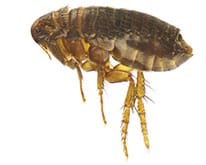Ticks & Fleas
Ticks
Ticks are small blood-sucking arachnids that vary in color depending on the species. Generally 1/8 to 1/4 of an inch in size, ticks are often found on a host (either a person or family pet) feeding. Ticks are vectors of a number of diseases including Lyme Disease, Rocky Mountain Spotted Fever and Tularemia.
Fleas
This insect's chief fame is attributed to their ability to transmit disease. The body of the flea is well adapted to its parasitic lifestyle. Dark-colored adults are flattened from side to side with many bristles that point backwards, facilitating forward movement through fur, hair or feathers. Fleas are wingless creatures, with strongly developed legs, and hind legs that are especially adapted for jumping. They have sucking mouth parts designed to feed on the blood of mammals and birds.
The most serious human disease transmitted by biting fleas is bubonic plague or the "Black Death" of the Middle Ages. Even though we are not at serious risk of this disease, fleas are common sources of skin lesions in humans. Some individuals become accustomed to fleas and are not disturbed by them. Others are extremely irritated by the presence of fleas, let alone their painful bites. The bite of a flea varies with the species and the person bitten.
The cat, dog and human flea are the intermediate host of dog tapeworm, a common problem in cats and dogs. There have even been reports that 24 percent of dogs and 30 percent of cats are infected with tapeworm - and according to experts, the incidence of dog tapeworm infestations in children may be more frequent than suspected.
Control
First of all, keep your home or facility as sanitary as possible. Another facet of flea control includes screening of foundation vents to keep pests, rats, opossum, squirrels and other flea hosts out from under the house or facility. Many times when dogs and other pets are allowed to seek shade under the house on a hot summer day, this can lead to a rapid buildup of a heavy concentration of fleas. Be sure to wash pets' bedding and vacuum pet resting and sleeping areas. The most important part of controlling fleas is the safe application of EPA-registered pesticide for fleas.





